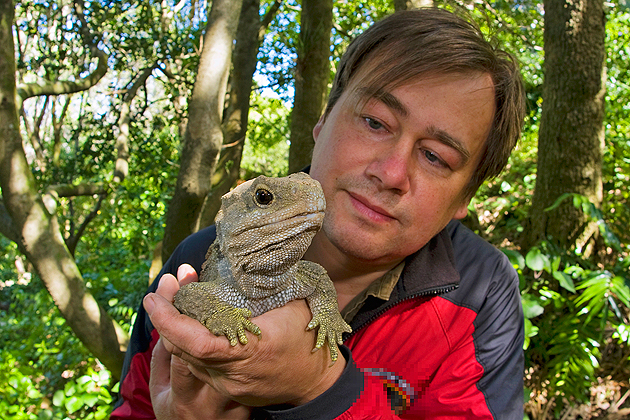
Through both photography and narrative, conservation biologist Piotr Naskrecki invites readers to explore a world that is little known, hoping to promote not only wonder in the natural world, but also interest in and public support for biodiversity. His recent book Relics: Travels in Nature’s Time Machine focuses on organisms and ecosystems that trace Earth’s evolutionary history.
Naskrecki earned his Ph.D. in entomology from UConn’s Department of Ecology and Evolutionary Biology, part of the College of Liberal Arts and Sciences, in 2000, and is currently a research associate and postdoctoral fellow at Harvard University’s Museum of Comparative Zoology. He also served for seven years as director of the Invertebrate Diversity Initiative at the Washington, D.C.-based organization Conservation International, during which time he established protocols that helped include insects and other invertebrate animals in worldwide conservation practices.
Naskrecki was on campus recently to discuss his latest book, which includes visits with the prehistoric-looking lizard tuatara, which is found only in New Zealand and whose closest relatives became extinct 100 million years ago; and to the Atewa Range Forest Reserve in Ghana, which boasts one of the most ecologically important habitats on the African continent.
Beneath the surface

While it may not be surprising to find unfamiliar species in exotic locales, Naskrecki also finds unusual life forms close to home. One of his stops is Estabrook Woods in Concord, Mass., where he introduces readers to the fascinating life cycle of fairy shrimp. These tiny crustaceans complete their life cycles while swimming largely unnoticed beneath the surface of vernal pools. The females are capable of laying both thin shelled “summer eggs” that mature and hatch rapidly, as well as “winter eggs” that remain in the mud as the pools dry up, only to hatch when the pools fill again during the rains that come the following spring.
He also explores a drama enacted each year on the beaches of the Delaware Bay, where 100,000 horseshoe crabs come to lay their eggs in late spring. Little changed in the last 250 million years, this arthropod is not really a crab at all, but is related to scorpions, ticks, and spiders.
In an effort to ensure proper appreciation of this ungainly looking creature, Naskrecki says the horseshoe crab is one of nature’s true ‘blue bloods’ due to the presence of copper in its blood. An extract of the horseshoe crab’s blood is used by the pharmaceutical and medical device industries in limulus amebocyte lysate (LAL) tests to ensure that products such as intravenous drugs, vaccines, and medical devices are free of bacterial contamination.
The future

While the photographs in Relics are breathtaking, the story is not always a happy one. “For people like Naskrecki, being a naturalist is like being an art historian in a world where a major art museum burns to the ground every year,” wrote Alex Wild in a blog in Scientific American. “Environmental destruction is emotionally devastating for those who find wonder in living things, and even though Naskrecki tries to find an uplifting tale here or there … it’s hard to escape the obvious. The magical world of floppy muppet spiders is doomed.”
Naskrecki doesn’t dispute the analogy. “Conservation biology is more and more becoming a salvage operation rather than a rescue operation,” he says. “We are trying to learn as much as we can about what’s remaining, and we are focusing our efforts on those things that are most important.
“With 26,000 species disappearing annually … that’s one every 20 minutes … and only about 15,000 to 20,000 new species being discovered, it’s a losing battle, but I think it’s one worth fighting,” he adds.
The main point of this book, according to Naskrecki, is that we need to preserve a broad sampling of genetic diversity rather than focusing on saving a particular number of species. “In simple terms,” he says, “what’s more important? To save five species of parrots that are not genetically diverse, or to save a kiwi, an ostrich, and a parrot? Clearly, it’s better to preserve as much diversity as possible.”
Broad appeal

From the time he was a child growing up in his native Poland, Naskrecki has been fascinated with the natural world; and it is the tiny creatures on earth that particularly concern him. While creatures such as peregrine falcons, whales, and pandas seem to attract a sympathetic public willing to fight for their survival, “when a beetle goes extinct,” he says, “nobody notices.”
Both Relics and Naskrecki’s previous book, The Smaller Majority, are written to have a broad appeal to scientists, amateur naturalists, and young people, alike, and that’s his goal. “It doesn’t really matter what a bunch of scientists think about conservation biology and genetic diversity if there’s no broad support from the general public,” he says, “especially the young people who will be the decision makers 10 or 15 years from now. That’s why I try to make my books appealing to thinking young people; they’re the ones we’ll need to depend on in the future.”


